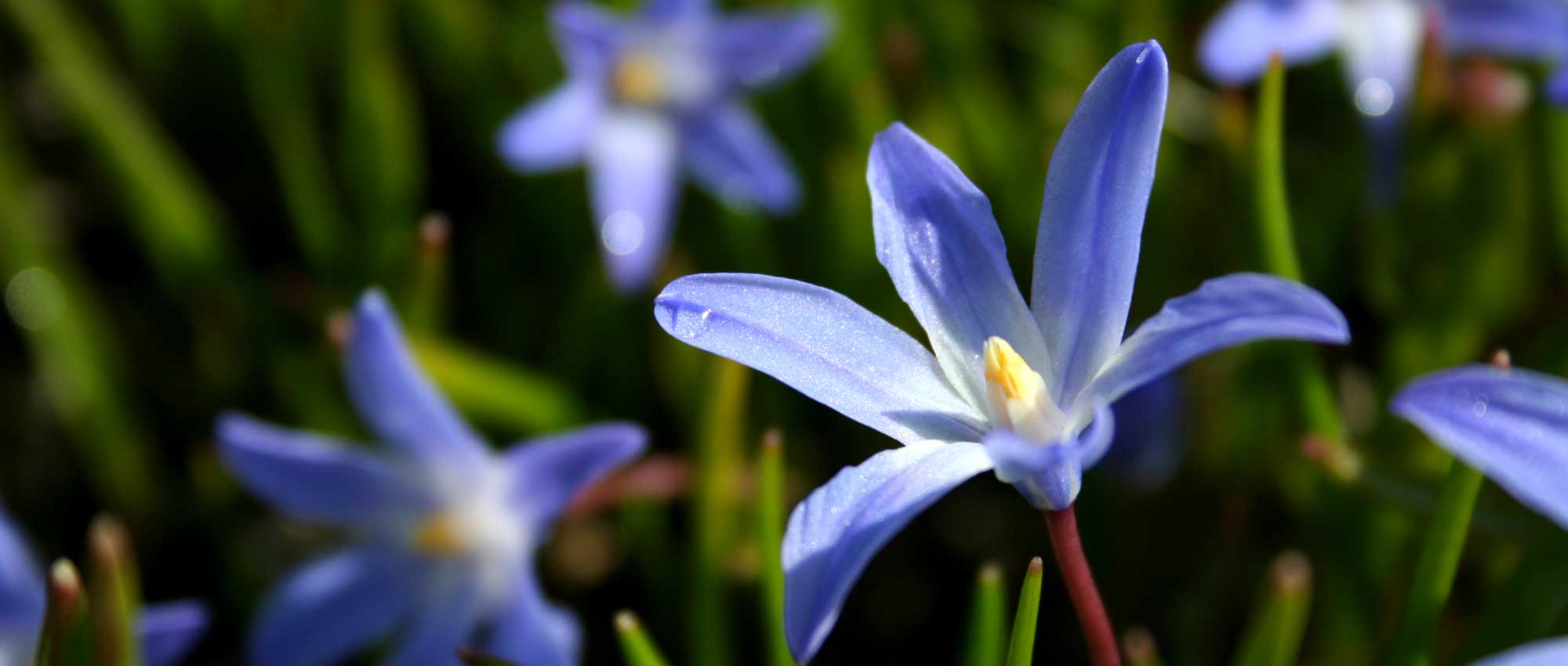
Chionodoxas: planting, growing and care
Contents
Chionodoxas in a nutshell
- Chionodoxas are bulbs that offer very early flowering, heralding spring!
- They are appreciated for their small star-shaped flowers, in soft tones, often blue, mauve, or white.
- They can form true tapetum of flowers, in a short grass meadow or in woodland.
- They are capable of naturalising and require virtually no maintenance.
- In full sun or partial shade, they grow at the edge of a flowerbed or in pots.
A word from our Expert
The Chionodoxa, or Glory of the Snow, is among the first spring bulbs to bloom, sometimes as early as the end of winter. It heralds spring with its star-shaped flowers that give it the appearance of a small hyacinth. This is a hardy bulbous plant, very easy to grow, with fine and discreet foliage, and delicate flowering in both soft and intense shades. Most of the time, the flowers are blue, with a white centre. There are also varieties with pink, mauve, or completely white flowers.
Once flowering is over, the foliage of the chionodoxa turns yellow and the plant enters dormancy. It becomes forgotten, making way for other blooms, only to return beautifully the following spring!
Requiring almost no maintenance, the chionodoxa is a prolific plant that can even naturalise in the garden! The clumps tend to spread over time. It is a small hardy perennial, not very susceptible to diseases and pests, and very resilient! The chionodoxa is planted in autumn, preferably in groups rather than individually. It is easy to multiply.
Chionodoxas have the ability to form true carpets of flowers! They are perfect for enlivening a short grass meadow or a woodland area, and can also be planted in rockeries. They are also suitable for the edges of flower beds… And if you wish to keep them close to the house, you can even grow them in pots or containers! Chionodoxas pair wonderfully with other late winter bulbs: daffodils, jonquils, snowdrops, botanical tulips, crocuses…
Botany
Botanical data
- Latin name Chionodoxa or Scilla sp.
- Family Asparagaceae
- Common name Chionodoxa, Glory of the Snow
- Flowering between February and April
- Height 10 to 20 cm
- Sun exposure preferably in full sun.
- Soil type well-drained, cool, rich and light
- Hardiness -20 to -25 °C
The chionodoxa is a small bulbous perennial plant that originates from Minor Asia (Eastern Mediterranean region), particularly from western Turkey, Crete, and Cyprus. It mainly grows in mountainous areas. It is a robust and very hardy plant that tends to naturalise in the garden. It is appreciated for its star-shaped and bright flowering.
The chionodoxa was formerly classified in the botanical family Liliaceae, but it is now classified in the Asparagaceae family. It is no surprise that the chionodoxa resembles a small hyacinth, as it belongs to the same botanical family! It also closely resembles puschkinias, another small bulbous plant from this family.
Chionodoxas are very close to scillas, and have recently been reclassified into the genus Scilla, whereas previously they had their own genus name, Chionodoxa. They have thus changed their scientific name! Botanists now consider that the differences between chionodoxas and scillas are not significant enough to justify them belonging to a distinct genus.
When classified separately, chionodoxas included six species. In cultivation, three are mainly found: Chionodoxa luciliae, Chionodoxa forbesii, and Chionodoxa sardensis, which are very similar. Indeed, the different species and varieties of chionodoxas are very close, leading to some confusion. Aside from a few nuances in shades, height, or the number of flowers per cluster, it is a relatively homogeneous group.
The chionodoxa is commonly known as “Glory of the Snow”. Its Latin name comes from the Greek chion: snow, and doxa: glory. In English, it is called glory-of-the-snow. Thus, whether in French, Latin, or English, all names for chionodoxa mean “Glory of the Snow”… Because in mountainous areas, its flowers appear when the snow melts, at the beginning of spring.
The chionodoxa appears at the end of winter, then blooms for two weeks, after which its foliage yellows, and it disappears, making way for other plants. It enters dormancy, remaining present in the form of a bulb in the soil, and will reappear the following year. It gives us an annual rendezvous to celebrate the beginning of spring!
Chionodoxas are small plants that measure between 10 and 20 cm in height. However, they can form very large carpets. The flowers are borne on a reddish, quite dark stem.
The chionodoxa blooms very early, at the end of winter or the beginning of spring, often around March, but in any case between February and April. It is one of the first plants to bloom, thus heralding spring. However, the flowering period is quite short: it lasts about two weeks.

The flowers of chionodoxa can take on different shades. Chionodoxa luciliae, Chionodoxa forbesii ‘Pink Giant’ (photo Steven Bemelman – iBulb) and Chionodoxa luciliae ‘Alba’
The chionodoxa produces small upright stems, reddish or purplish, that bear lovely star-shaped flowers. They are gathered in clusters, which, depending on the species, can contain between two and twelve flowers. Each flower is borne on a long peduncle.
The flowering is often blue, but can also be purple or white. It comes in always very soft shades. The flowers measure one to two centimetres in diameter. They are composed of six tepals (undifferentiated petals or sepals) marked by a darker central line. These tepals are also lighter at the base, creating a white circle at the centre of the flower. This adds more brilliance to the flowers, making them appear almost shiny! In the centre, six yellow stamens provide even more brightness. The chionodoxa has a delicate, quite simple flowering, but it is very charming!
Each bulb produces two or three leaves that emerge from the base, from the soil, and measure between 8 and 25 cm in length. The leaves are very elongated, narrow, linear, and quite thick. They are not really flat, but rather incurved in a gutter shape. They have a dark green hue. It is a rather ordinary and discreet foliage, but it is appreciated for its fineness. It somewhat resembles the foliage of hyacinths… No surprise there, as these two plants belong to the same family!
The chionodoxa has a bulb that allows it to store reserves and spend a good part of the year underground, in dormancy. It is planted and sold in bulb form. This also allows for easy multiplication.
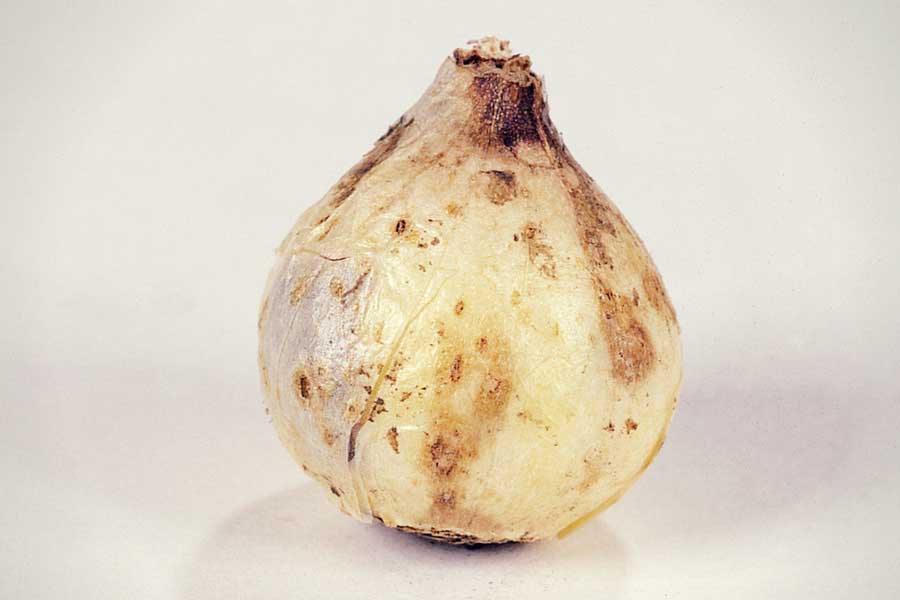
A chionodoxa bulb (photo iBulb – Fotostudio Artifex)
The fruit of the chionodoxa is a three-chambered capsule. It opens at maturity to release the seeds it contains.
Chionodoxas are very hardy plants, tolerating temperatures between -20 and -25 °C. They even prefer cool climates and will thrive more in the north of the Loire than in the Mediterranean region! Their flowering is less generous in a mild climate.
The main varieties of chionodoxa
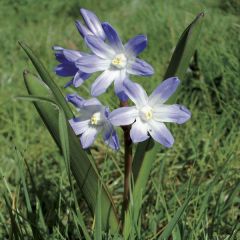
Chionodoxa luciliae
- Flowering time March to May
- Height at maturity 15 cm
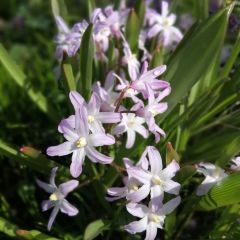
Chionodoxa forbesii Pink Giant
- Flowering time March to May
- Height at maturity 15 cm
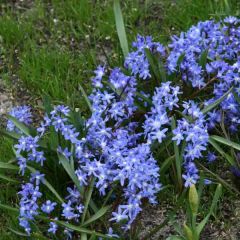
Chionodoxa sardensis
- Flowering time April, May
- Height at maturity 15 cm
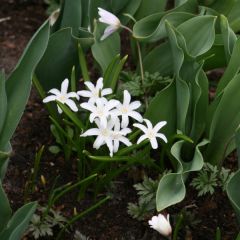
Chionodoxa luciliae Alba
- Flowering time March to May
- Height at maturity 12 cm
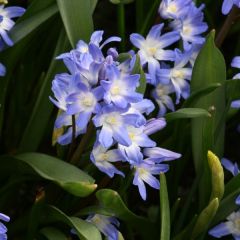
Chionodoxa forbesii Blue Giant
- Flowering time March to May
- Height at maturity 10 cm
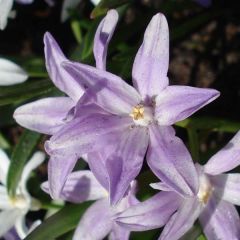
Chionodoxa forbesii Violet Beauty
- Flowering time April, May
- Height at maturity 10 cm
Discover other Chionodoxa
View all →Available in 1 sizes
Available in 1 sizes
Available in 1 sizes
Available in 1 sizes
Available in 1 sizes
Available in 1 sizes
Available in 1 sizes
Available in 1 sizes
Available in 1 sizes
Planting
Where to plant?
Plant chionodoxas preferably in full sun, or possibly in partial shade. You can certainly place them at the base of deciduous trees or bushes. In any case, they appreciate good light.
Chionodoxa is an easy, low-maintenance plant that adapts to almost any type of soil. However, it prefers rich, organic, fertile soils, as well as loose, light, and permeable soils. It will also appreciate a relatively cool, yet well-draining soil, as stagnant moisture could cause the bulbs to rot.
You can plant it in masses in the middle of a short grass meadow and let it naturalise. You will achieve splendid carpets of blue flowers! Chionodoxa is also suitable for rockeries, alongside alpine plants. For a very natural effect, you can plant it in a bright woodland, accompanied by other early flowering bulbs.
You can also grow chionodoxa in pots or containers, for example alongside other small bulbs. Use a well-draining, sandy medium.
Chionodoxa thrives in regions with a relatively cool, even cold climate. In warmer areas, under a mild climate, flowering will be less abundant. It is a plant perfectly suited for alpine gardens and mountainous regions.
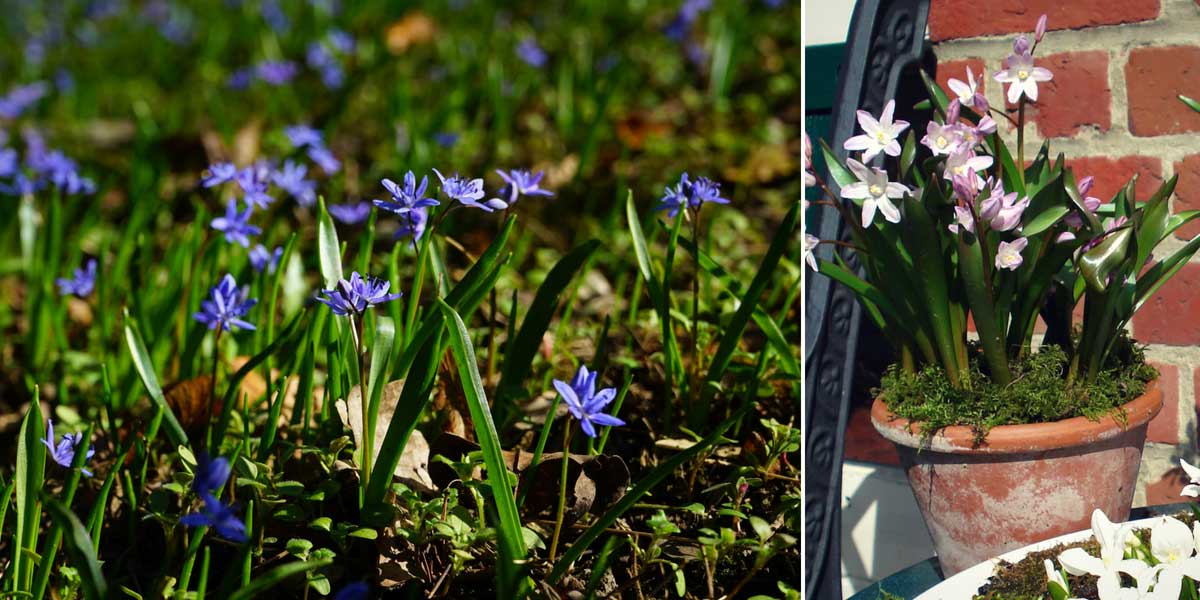 You can plant chionodoxas in the ground, for example in a short grass meadow, or in pots
You can plant chionodoxas in the ground, for example in a short grass meadow, or in pots
When to plant?
Chionodoxa is planted in early autumn, ideally in September or October, but can be planted until December, while the bulb is still in dormancy, and before temperatures become too cold.
How to plant?
You can plant your chionodoxas in large groups, to create, for example, a flowering carpet in a short grass meadow. In this case, we recommend tossing the bulbs onto the ground and planting them where they fall, so they are randomly distributed for a very natural effect!
You can also scatter a few bulbs in a flower bed; however, due to their small size, it is better to place them towards the front of the bed, alongside other low plants (muscari, ophiopogon, primroses, etc.).
In any case, we recommend planting at least ten bulbs each time. Maintain a distance of about 5 to 8 cm between each bulb.
- Start by working the soil to loosen it, aerate it, and possibly add some potting soil.
- Dig a small planting hole. Feel free to add drainage materials, such as coarse sand. This will allow water to drain away to prevent the bulb from rotting.
- Place the bulb, in the correct orientation, with the point facing upwards. It should be positioned between 8 and 10 cm deep.
- Cover with soil.
- Lightly firm the soil.
- Water generously.
If you wish to grow chionodoxas in pots, preferably choose a fairly wide container, then place a drainage layer at the bottom (gravel, broken pot pieces, pumice…). Plant in a well-draining medium (for example, a mix of potting soil and sand). Water. Place the pot in a sunny location.
Care
Chionodoxa requires almost no maintenance. The following guidelines are quite optional; chionodoxas can thrive in the garden without any intervention.
After flowering, the bulb replenishes its reserves. The leaves then begin to yellow, but you must wait until they are completely dried before cutting them. It is important not to cut back the foliage too early! This allows the plant to accumulate nutrients to bloom again the following year. Similarly, if you have planted your chionodoxas in a short grass meadow, you will need to wait until the leaves have yellowed before mowing the lawn!
You can remove faded flowers, but we recommend leaving a few in place to collect seeds or allow them to self-seed! Chionodoxas can naturalise.
You can divide your chionodoxas after three to four years of cultivation. This will help rejuvenate the clumps and possibly replant them in another location or give bulbs to your friends!
Chionodoxas may require some watering during flowering if the soil is dry. In pots, you can water (without overdoing it!) during the growing season to keep the soil moist. Excessive moisture could cause the bulb to rot. The soil should remain relatively dry in summer when the plant is in dormancy.
Chionodoxa is not particularly susceptible to diseases and pests. The only real cultivation problem you may encounter is stagnant moisture, which can rot the bulbs.
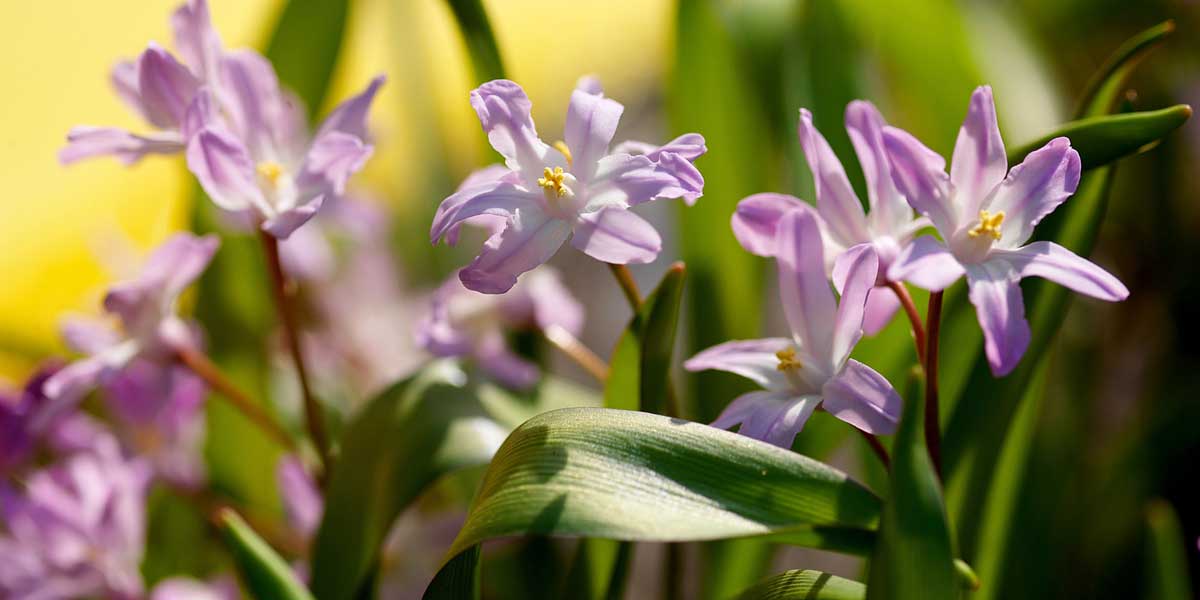
Chionodoxa forbesii Pink Giant (photo Steven Bemelman – iBulb)
Multiplication
You can multiply chionodoxas by sowing or division. Both operations are carried out in summer. Chionodoxas are prolific plants that tend to multiply spontaneously and sometimes naturalise themselves.
Sowing
You can harvest the seeds contained in the capsules of chionodoxas. Sow preferably in summer.
- Prepare a pot by filling it with special sowing compost.
- Sow the seeds.
- Lightly cover with a bit of substrate.
- Water with a fine spray.
- Place the pot under a cold frame, out of direct sunlight.
You can transplant them into individual pots as soon as they reach a size that allows for handling.
You will then need to wait a few years (about 4 years) before you see them flower!
Division of Clumps
After three to four years of cultivation, you can divide the densest clumps. Do this in summer, when the plant has entered dormancy and the foliage has dried. This will allow you to regenerate your plants!
- Choose a well-established, dense clump that has been in place for several years. Dig it up using a fork.
- Separate the bulbils from the original bulb. You can sort them to keep only the best ones.
- Replant them in another location, after properly preparing the soil.
Association
Chionodoxa is perfect for accompanying other spring bulbs! You can plant it alongside botanical tulips, daffodils, crocuses, muscari, hyacinths, or ipheions, for example. These are plants that share the same rhythm, are planted in autumn, and offer delicate flowering in spring. You will easily find them in shades that complement the flowers of chionodoxas.
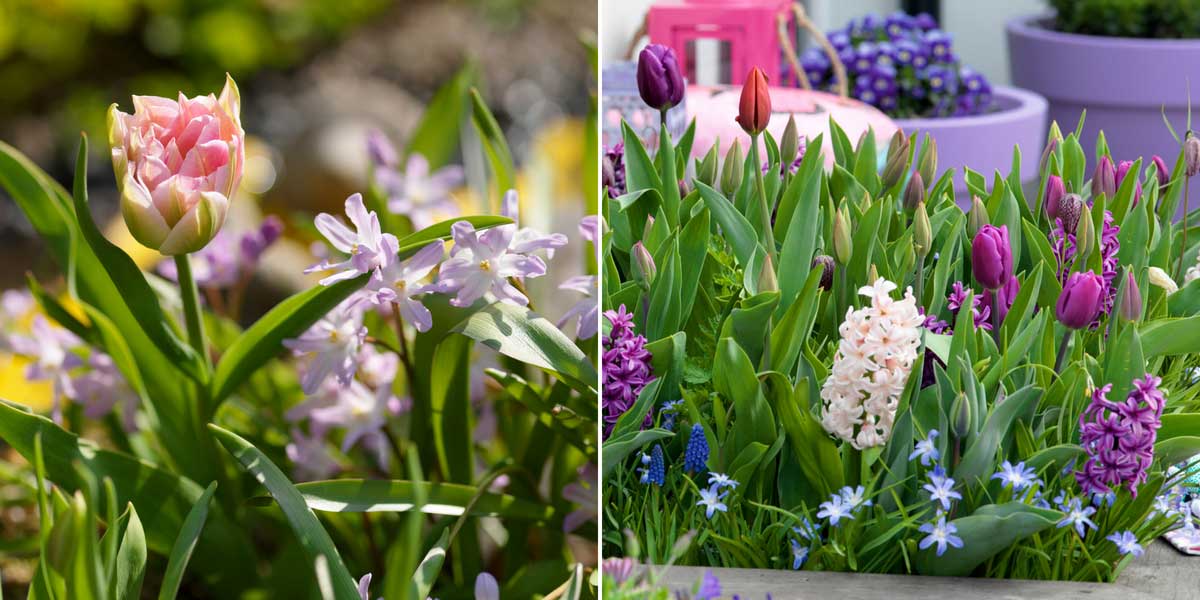
Chionodoxas pair wonderfully with spring bulbs! Chionodoxa forbesii Pink Giant and Tulip (photo Steven Bemelman – iBulb) / Chionodoxa luciliae, Tulips, Hyacinths, and Muscari (photo F-Studio – iBulb)
Make the most of chionodoxa to create a beautiful late winter scene! To celebrate the arrival of spring, plant chionodoxa with other early bloomers: Anemone blanda, Pulsatilla vulgaris, snowdrops or nivéoles, Eranthis hyemalis… not forgetting the elegant flowering of Oriental hellebores! Pair them with some bushes, such as witch hazel, forsythia, or camellia… Also enjoy the fragrant flowering of Daphne odora, or the stunning white flowers of Abeliophyllum distichum!
You can also plant them in groups in a short grass meadow. They will create a carpet of blue flowers that will spread over time. You can accompany them with some botanical tulips, crocuses, or daffodils… Scatter these bulbs randomly in your meadow to achieve a very natural effect. It will be covered in colourful flowers at the start of each spring!
Chionodoxa is also an excellent small rock garden plant. You can plant a few clumps alongside other alpine plants, ground cover plants, and small bulbous plants. Pair it with Phlox subulata, ipheions, as well as small rock irises, such as Iris reticulata, or botanical tulips like Tulipa turkestanica or Tulipa humilis. You can add some sedums, houseleeks, or grasses.
As chionodoxas are small plants, they can be planted at the edge. You can plant them in a line to highlight a path, a flowerbed, or the foot of a hedge…
Chionodoxa will also find its place in a bright woodland. Use it to form a carpet of flowers at the foot of deciduous trees, alongside anemones, Eranthis hyemalis, or the delicate blue flowers of Hepatica nobilis. You will achieve a very natural-looking garden!
You can also enjoy chionodoxas to create a floral arrangement in a pot or window box! Pair them with pansies, stemless primroses, muscari… Feel free to add some decorative foliage, such as that of carex, ivy, or muhlenbeckia.
Finally, the different varieties of chionodoxas have colours that blend well together, in fairly similar tones. Discover our collection, which combines three varieties!
→ Discover more pairing ideas with Chionodoxa in our advice sheet!
Useful resources
- Discover our range of chionodoxas!
- An article by Ingrid on our blog – Planting bulbs? 7 practical and useful tips!
- An article by Pierre on our blog – Small bulbs, big impact!
- An interesting article on chionodoxa
- Bulb size: understanding to make better choices
- Our advice sheet: 9 blue flowering bulbs to have in your garden
- Our advice sheet: Chionodoxa: our favourite varieties
Frequently asked questions
-
Can I cut the foliage of my chionodoxa now that it has finished flowering?
After flowering, chionodoxa needs its leaves to store reserves in the bulb before entering dormancy and flowering again the following spring. Allow the foliage to fade naturally. You can cut it once it is completely yellow and dried out.
- Subscribe!
- Contents
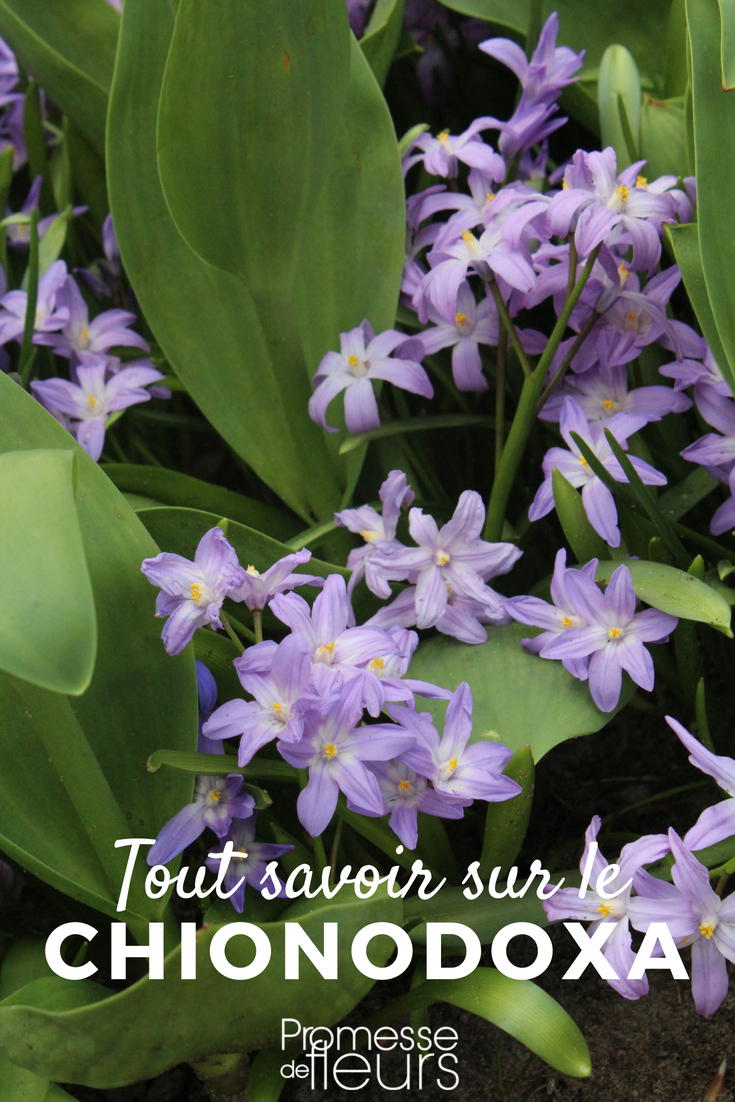































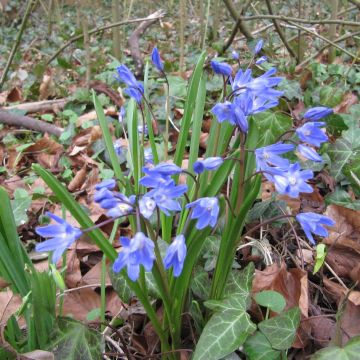



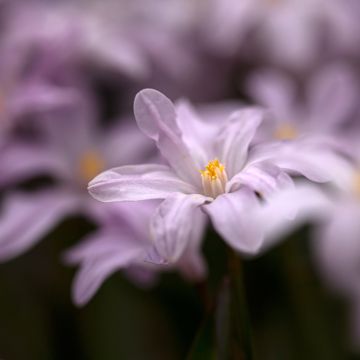
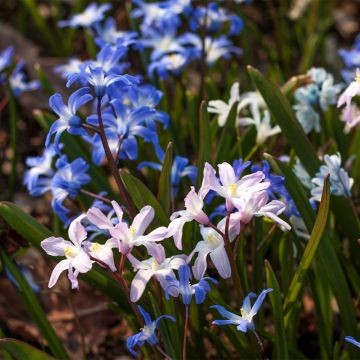



Comments